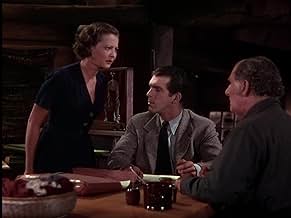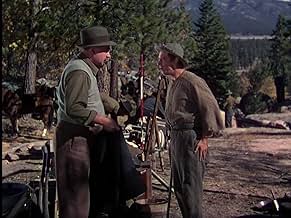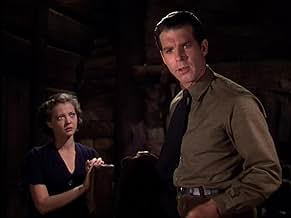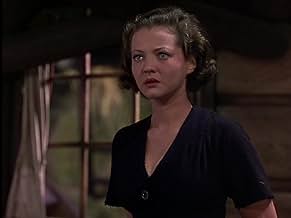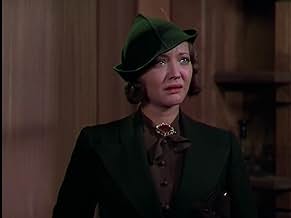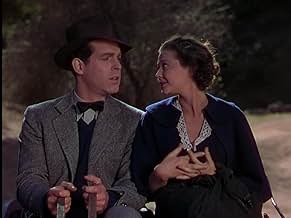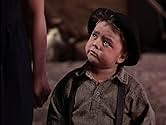VALUTAZIONE IMDb
6,8/10
1472
LA TUA VALUTAZIONE
Aggiungi una trama nella tua linguaA railroad man from the city befriends a mountain girl in a Kentucky family feud.A railroad man from the city befriends a mountain girl in a Kentucky family feud.A railroad man from the city befriends a mountain girl in a Kentucky family feud.
- Regia
- Sceneggiatura
- Star
- Candidato a 1 Oscar
- 5 vittorie e 2 candidature totali
George 'Spanky' McFarland
- Buddie Tolliver
- (as Spanky McFarland)
Samuel S. Hinds
- Sheriff
- (as Samuel Hinds)
Henry Brandon
- Wade Falin
- (as Henry Kleinbach)
Jess Barker
- Merd Falin
- (as Philip Barker)
Recensioni in evidenza
8tavm
Just watched this Technicolor Paramount feature (The first of the kind that was shot outdoors) on YouTube. While it had stars like Fred MacMurray, Henry Fonda, and Sylvia Sidney, the main reason I was interested in this movie was because of one Spanky McFarland, who at the time was still a member of "Our Gang". This was a compelling story of a couple of feuding families and one outsider played by MacMurray who's trying to build a railroad around both respective groups' areas. There's also a romantic rivalry between Fonda and MacMurray for Sidney. Also appearing were Beulah Bondi, Nigel Bruce, and Samuel Hinds as the Sheriff. (If anyone is familiar with me, they know my favorite movie is It's a Wonderful Life and I like noting actors in that movie in other films like Bondi and Hinds who were married in the latter) Then there's Fuzzy Knight who's a charmer as something of a Greek chorus singing songs like "Twlight on the Trail" and the Oscar-nominated "A Melody from the Sky". Incidentally, while Knight sings the latter, Fonda whistles and Spanky hums and this was a couple of years before Spanky's "Our Gang" co-star Alfalfa sung part of this tune in the short The Little Ranger (which McFarland doesn't appear in). Anyway, this was a fine showcase for the Technicolor photography as kudos to director Henry Hathaway for making every scene count as this was a most entertaining drama with a couple of touching, though tragic, scenes at the end. So on that note, I highly recommend The Trail of the Lonesome Pine.
THE TRAIL OF THE LONESOME PINE (1936) is a landmark color film of considerable dramatic power that has been neglected in Hollywood history. It was the second full-length feature to be produced in the newly-developed 3 strip Technicolor process. The first Technicolor feature, BECKY SHARP, had opened the previous year (1935) but did not find audience favor. There is strong evidence to suggest that THE TRAIL OF THE LONESOME PINE was the film that really popularized color.
Aside from the superb color photography, the film has much to recommend it. There are very strong performances, particularly that of Sylvia Sidney as the backwoods mountain girl - a very convincing portrayal. She is supported by two handsome newcomers, Henry Fonda and Fred MacMurray, plus veterans such as Fred Stone, Beulah Bondi, and Spanky MacFarland. The story line is very compelling and there is the strong direction of Henry Hathaway (LIVES OF A BENGAL LANCER, KISS OF DEATH, TRUE GRIT). In its original release, audiences reportedly burst into applause while viewing some of the color scenes. The film was a box office smash for Paramount, playing to packed houses in both large and small towns. (This is well documented.) It remains compelling entertainment today. The high-quality color photography was very much in evidence in the VHS tape that MCA released in the Nineties. It is to be hoped that the same high quality will be seen in the projected 2009 DVD release of this beloved film.
Aside from the superb color photography, the film has much to recommend it. There are very strong performances, particularly that of Sylvia Sidney as the backwoods mountain girl - a very convincing portrayal. She is supported by two handsome newcomers, Henry Fonda and Fred MacMurray, plus veterans such as Fred Stone, Beulah Bondi, and Spanky MacFarland. The story line is very compelling and there is the strong direction of Henry Hathaway (LIVES OF A BENGAL LANCER, KISS OF DEATH, TRUE GRIT). In its original release, audiences reportedly burst into applause while viewing some of the color scenes. The film was a box office smash for Paramount, playing to packed houses in both large and small towns. (This is well documented.) It remains compelling entertainment today. The high-quality color photography was very much in evidence in the VHS tape that MCA released in the Nineties. It is to be hoped that the same high quality will be seen in the projected 2009 DVD release of this beloved film.
I bought a video of this film on Amazon.com after reading the 1908 novel by John Fox Jr. and enjoying it very much. I waited 4 whole months for Amazon to locate a copy and ship it to me. Then I settled down to watch it and almost fell asleep. I was disappointed after all that wait.
Sylvia Sidney and Fred MacMurray were terribly miscast as the leads June and Jack, Fred more so than Sylvia. Henry Fonda was very good as Dave, although his lines were hokey. The script was not true to the book at all; that was the main problem. All the protective tenderness the lead male Jack felt for the girl June, so beautifully portrayed in the novel, was totally missing in Fred MacMurray's performance. And then to top it off they had little Spanky from the Our Gang series in it as the little brother of June, his chubby face and coy demeanor were distractions from the main action of the story. The songs that were sung were annoying too; had no place in the story. It would have been better if they had spent money on a better musical soundtrack without characters singing all the time, especially in dramatic scenes. What were they thinking? (no doubt, of sheet music sales). Some outdoor scenes were beautiful filmed in color but that alone cannot hold the viewer's interest in the movie. Even the significance and symbolism of the Pine Tree in June and Jack's relationship wasn't portrayed in the film as it should have been.
Anyway, my advice here is to skip the film and just read the book and enjoy it. Since this story is in the public domain it could really be updated today and make a nice film. Maybe someday some studio or independent filmmaker will consider it. There were 4 silent versions and an animated version made prior to this film, so obviously the story is a classic one that can be enjoyed by new generations, if told well and with sensitivity and faithfulness to the book by John Fox.
Sylvia Sidney and Fred MacMurray were terribly miscast as the leads June and Jack, Fred more so than Sylvia. Henry Fonda was very good as Dave, although his lines were hokey. The script was not true to the book at all; that was the main problem. All the protective tenderness the lead male Jack felt for the girl June, so beautifully portrayed in the novel, was totally missing in Fred MacMurray's performance. And then to top it off they had little Spanky from the Our Gang series in it as the little brother of June, his chubby face and coy demeanor were distractions from the main action of the story. The songs that were sung were annoying too; had no place in the story. It would have been better if they had spent money on a better musical soundtrack without characters singing all the time, especially in dramatic scenes. What were they thinking? (no doubt, of sheet music sales). Some outdoor scenes were beautiful filmed in color but that alone cannot hold the viewer's interest in the movie. Even the significance and symbolism of the Pine Tree in June and Jack's relationship wasn't portrayed in the film as it should have been.
Anyway, my advice here is to skip the film and just read the book and enjoy it. Since this story is in the public domain it could really be updated today and make a nice film. Maybe someday some studio or independent filmmaker will consider it. There were 4 silent versions and an animated version made prior to this film, so obviously the story is a classic one that can be enjoyed by new generations, if told well and with sensitivity and faithfulness to the book by John Fox.
`In the Blue Ridge Mountains of Virginia, on THE TRAIL OF THE LONESOME PINE,' a young woman discovers love, but no respite from the violent feud which has torn apart two families.
Full of good performances & boasting excellent production values courtesy of Paramount Studios, this fine drama brings to its viewers a not-so-subtle message of peace & tolerance. The vividly depicted consequences of mindless, violent behavior give the film a real punch.
The film's romantic triangle consists of barefoot mountain lass Sylvia Sidney, her decent, uncomplicated cousin Henry Fonda, and mining executive Fred MacMurray, who, as a newcomer to the backwoods, rebels against the traditions of violence & revenge he finds there. All three deliver compelling performances, with a slight advantage going to the gentlemen, as their roles do not require as much shrill, fickle behavior as does Miss Sidney's.
The marvelous character actress Beulah Bondi appears as Miss Sidney's mother, one of the first in a decades-long line of stubborn, proud old women she would play; her eyes tell of the world of trouble her character has seen on the mountain. Cuddly Nigel Bruce is MacMurray's associate - gruff & grumbly, but with a heart of gold.
Special mention should be made of seven-year-old Spanky McFarland, who plays Miss Sidney's little brother. Already the star of numerous OUR GANG comedies, the tiny tyke here displays the talent that placed him in the front rank of child movie stars. Precocious & poignant, Spanky's character is quite unforgettable.
Fred Stone & Robert Barrat play the heads of the two feuding clans, one gentle - the other fierce. Movie mavens will recognize Clara Blandick as a frightened landlady and Samuel S. Hinds as the Gaptown sheriff.
The film is stitched together by the evocative, nostalgic singing of Fuzzy Knight, who introduces Twilight On The Trail' & A Melody From The Sky,' (both by Louis Alter and Sidney D. Mitchell). The tune for the chorus of The Trail Of The Lonesome Pine,' by Ballard MacDonald & Harry Carroll, can be briefly heard during the opening credits; viewers will need to watch Laurel & Hardy's WAY OUT WEST (1937) to hear this fine old song actually sung.
Famous as the first outdoor film produced in full Technicolor, THE TRAIL OF THE LONESOME PINE benefits greatly from its location filming near Cedar Lake, in California's San Bernardino Mountains.
Full of good performances & boasting excellent production values courtesy of Paramount Studios, this fine drama brings to its viewers a not-so-subtle message of peace & tolerance. The vividly depicted consequences of mindless, violent behavior give the film a real punch.
The film's romantic triangle consists of barefoot mountain lass Sylvia Sidney, her decent, uncomplicated cousin Henry Fonda, and mining executive Fred MacMurray, who, as a newcomer to the backwoods, rebels against the traditions of violence & revenge he finds there. All three deliver compelling performances, with a slight advantage going to the gentlemen, as their roles do not require as much shrill, fickle behavior as does Miss Sidney's.
The marvelous character actress Beulah Bondi appears as Miss Sidney's mother, one of the first in a decades-long line of stubborn, proud old women she would play; her eyes tell of the world of trouble her character has seen on the mountain. Cuddly Nigel Bruce is MacMurray's associate - gruff & grumbly, but with a heart of gold.
Special mention should be made of seven-year-old Spanky McFarland, who plays Miss Sidney's little brother. Already the star of numerous OUR GANG comedies, the tiny tyke here displays the talent that placed him in the front rank of child movie stars. Precocious & poignant, Spanky's character is quite unforgettable.
Fred Stone & Robert Barrat play the heads of the two feuding clans, one gentle - the other fierce. Movie mavens will recognize Clara Blandick as a frightened landlady and Samuel S. Hinds as the Gaptown sheriff.
The film is stitched together by the evocative, nostalgic singing of Fuzzy Knight, who introduces Twilight On The Trail' & A Melody From The Sky,' (both by Louis Alter and Sidney D. Mitchell). The tune for the chorus of The Trail Of The Lonesome Pine,' by Ballard MacDonald & Harry Carroll, can be briefly heard during the opening credits; viewers will need to watch Laurel & Hardy's WAY OUT WEST (1937) to hear this fine old song actually sung.
Famous as the first outdoor film produced in full Technicolor, THE TRAIL OF THE LONESOME PINE benefits greatly from its location filming near Cedar Lake, in California's San Bernardino Mountains.
10diviv
The Trail of the Lonesome Pine is a beautiful tear-jerker.The characters are simple and honest. The setting is in hill-billy country. The simple folk there are trying to prevent a railroad running through their area and upsetting their way of life. To add to their stress is a continual family feud. In this movie we see the best and the worst in people. The acting is top-notch. A handkerchief is a must for this movie.
Lo sapevi?
- QuizParamount's first Technicolor feature and the first feature to be shot in Three-Strip Technicolor outside of a studio environment (on location).
- BlooperThe mud on June Tolliver changes thickness and shape between shots. It also changes from wet to dry and then back to wet.
- Citazioni
Melissa Tolliver: I was born old...
- Curiosità sui creditiThe opening credits (except for the Paramount logo) all appear as if they had been printed on tree barks.
- ConnessioniEdited into The Our Gang Story (1994)
I più visti
Accedi per valutare e creare un elenco di titoli salvati per ottenere consigli personalizzati
- How long is The Trail of the Lonesome Pine?Powered by Alexa
Dettagli
- Data di uscita
- Paese di origine
- Lingua
- Celebre anche come
- The Trail of the Lonesome Pine
- Luoghi delle riprese
- Aziende produttrici
- Vedi altri crediti dell’azienda su IMDbPro
- Tempo di esecuzione
- 1h 42min(102 min)
- Proporzioni
- 1.37 : 1
Contribuisci a questa pagina
Suggerisci una modifica o aggiungi i contenuti mancanti

